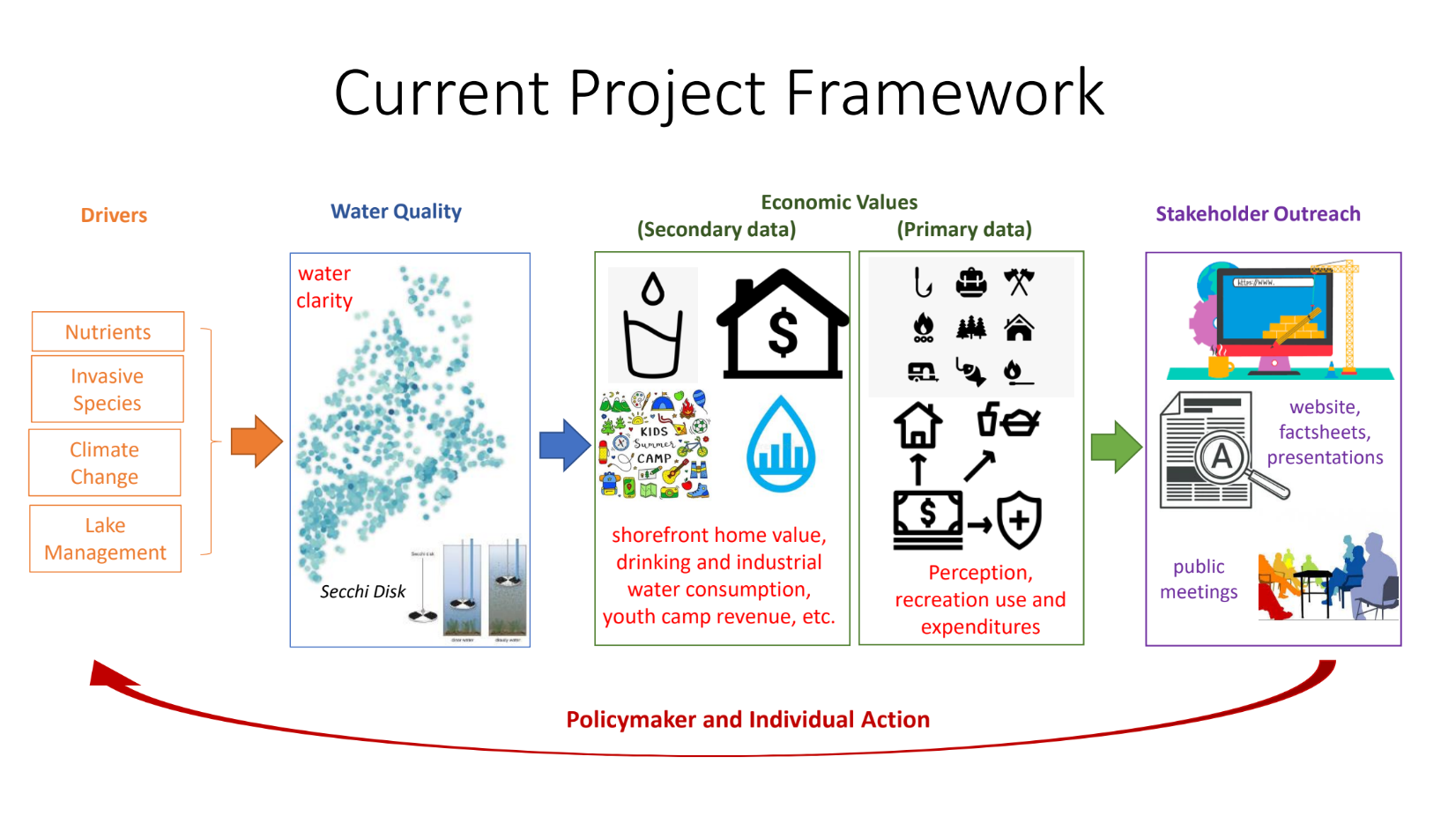Valuing the Economic Benefits of Maine’s Great Ponds in the 21st Century
Executive summary
Dr. Adam Daigneault, Melissa Genoter, Dr. Jianheng Zhao, Dr. Keith Evans, University of Maine, Susan Gallo, Maine Lakes,
Linda Bacon, Maine Department of Environmental Protection, April 1, 2024
Overview
Maine’s 6,000 lakes and ponds are a beloved feature of our state, providing beautiful landscapes, outdoor recreation opportunities, and generations of memories. However, Maine’s lakes have continue to face increasing challenges and pressures such as development, invasive species, and climate change, prompting a new assessment of their economic value to guide conservation efforts effectively. This study uses a range of methodologies such as travel cost modeling, expenditure analysis, surveys and hedonic price analysis to conduct a comprehensive assessment focused on recreation, water consumption, youth camps, and the impact of water quality on property values. We estimate that the total net economic value of Maine’s Lakes is over $14 billion, with the largest contribution coming from lakefront properties, followed by recreation trips. We also find that property owners place a premium on improved water quality: a one-foot increase in water clarity correlates with a 1.1% increase in property values. In addition, Maine’s lakes are estimated to generate at least $2.1 billion/yr in direct sales and expenditures via paying for things like meals, gas, and lodging for lake visits, summer camp tuition, and lakefront home taxes and maintenance. Accounting for the indirect sales that these activities support suggests that Maine’s lakes yield a total of more than $3 billion/yr in direct and indirect sales.
An accompanying survey of Maine residents on use and perceptions of lake water quality emphasizes the importance of water clarity on recreation choices, with the average visitor indicating lake quality is at least safe for swimming, if not higher. We estimate that a moderate decline in water quality is predicted to reduce total recreation use value by 6%, or $33 million per year. Our study emphasizes the need for sustainable management of Maine's water bodies, considering ecological, social, and economic factors, suggesting investing in that maintenance and improvement in the quality of Maine’s lakes are likely to provide a high return. The findings also offer significant evidence for policymakers to account for a wide range of values when deciding how to best allocate resources to manage Maine’s lakes.
methodology
This study estimated the economic contribution for a range of uses for Maine’s lakes through two common approaches, as was done in a similar study by Boyle et al. (1997). First, the net economic value that lakes and ponds provide represent the maximum amount someone is willing to pay for a given activity less the actual cost incurred to consume or participate in the activity. Second, the direct and indirect expenditures associated with the area of interest represent the level of economic or financial activity that Maine’s lakes provide through monetary transactions. Typically, lakes with higher water quality and amenity values will yield higher net economic values. We focused on data and analysis on about 150 lakes across Maine that very in size, location, quality, and use. These findings were then scaled up to generate state level estimates. Collectively, this approach estimated us to estimate the total economic contribution and value of Maine’s lakes, and then disseminate findings to broad stakeholders (Figure 1).
1Boyle, K., Schuetz, J., & Kahl, J.S., (1997). Great Ponds Play an Integral Part in Maine’s Economy. Water Research Institute, University of Maine. REP 473, April 1997

Figure 1. Key components, drivers, data and outreach materials of WRRI research project.
Key data used to estimate the economic contribution of Maine’s lakes include water quality metrics (e.g., water clarity), recreation use and expenditures, water consumption, summer camp visitation, and lakefront property values. Methods employed included survey design and enumeration, travel cost modeling, hedonic price analysis, and direct and indirect expenditure analysis (Table 1). Primary data on lake quality and use perception, recreation use, and expenditures were obtained via an online survey of Maine residents administered in spring 2023. The survey was distributed via the internet to the general public – including non-lake users – residing all over the state. The design included several quotas (e.g., geographical location, ethnicity, education) that resulted in a representative sample of 768 respondents. Key information collected in the survey included public perceptions of lake use and water quality, the number, timing, and expense of single-day and overnight trips to lakes over a 12-month period, and opportunities and barriers to visiting and using lakes more often.


study findings
The total net economic value of Maine’s lakes is estimated at $14.2 billion, with the largest contribution coming from lakefront properties, followed by recreation trips (Table 2). In addition, Maine’s lakes are estimated to generate at least $2.1 billion/yr in direct sales and expenditures via paying for things like meals, gas, and lodging for lake visits, summer camp tuition, and lakefront home taxes and maintenance. Accounting for the indirect sales that these activities support results in a total of $3.0 billion/yr in direct and indirect sales.
Lakefront Properties
Hedonic pricing analysis was applied to sales data for lakefront homes purchased between 2017 and 2022 and Secchi depth readings (an indicator of water quality) from more than 150 representative lakes across the state. Data collected include water quality, housing attributes (e.g., shorefront footage, size, distance to town, etc.), and wider community characteristics (population density, school district ratings, etc.). We estimate that Maine’s lakefront homes have a cumulative value of more than $13.3 billion dollars. Further, we’ve also estimated that a 1 foot increase in Secchi disk depth associated with improved water quality will increase the values of Maine homes located within 1,000 ft of the lake shore by an average of 1.1%. Water quality was found to have the largest influence on home values in the Lewiston-Auburn, Augusta, and Ellsworth lake regions of the state.
Lakefront property owners contribute to economic activity through the tax payments and investments (including maintenance and improvement) they make that are unique to their lake location. These generate $781 million annually in direct expenditures across the state along with another $85 million in indirect sales.
Recreation Use
The statewide lake use and perception survey (n = 768) estimated that about 77% Maine’s residents visited over 350 different lakes or ponds over a 12-month period in 2022-2023. Among them, Sebago Lake was visited most (22% of survey respondents who indicated they visited lakes), followed by Moosehead Lake (13%). Those who visited a lake took an average of 13.3 single-day trips and 2.6 overnight trips (averaging 4.4 days/trip). Incorporating the survey data into a travel cost model, we estimated the net value of a single day trip to a lake in Maine is $33.80/trip. Aggregating these results to the Maine population yields a total statewide annual lake recreation value of $501 million/yr. The survey also indicated that the average Mainer who visited a lake rated its water quality at an 8 out of 10 on the EPA water quality ladder (i.e., safe for swimming but not safe to drink), and that a reduction in water quality equivalent to two points on the ladder (i.e., a moderate decline) will reduce the total annual recreation use value by about 6%, or $33 million/yr.
In terms of expenditures, we estimated that Mainers spend about $1 billion per year related to lake travel and recreation, which generated an additional $586 million in indirect expenditures. Most of the expenditures were associated with food and beverage (42%), camping and picnicking supplies (17%), and equipment rental (16%). Overnight lake visitors reported spending about 18% of their total budget on lodging.
Water Consumption
Using the 2020 Annual Reports to the Maine Public Utilities Commission, we calculated the direct expenditure and value from total water consumption sourced from Maine’s lakes. Nearly half of Maine’s 100 water districts utilize lake-based sources to provide water to more than 50% of Maine residents. Because water district reports typically listed total water consumption, we assumed that values and revenues reported were for both residential and commercial uses. We estimated the value of public drinking to be roughly $334 million/year, or about $2.10/resident/day. Direct expenditures on water consumption were about $126 million/yr. Accounting for the indirect expenditures generated by lake-sourced residential and commercial water uses yields a total of $241 million/yr in direct and indirect sales.
Summer Camps
We estimated that there are 91 summer camps on Maine’s lakes and ponds (approx. 73% of all youth camps in Maine), for which about 48,000 campers attend every year. Based on data accrued from various summer camps, we estimated that the average tuition cost for an overnight camp is $2,262/week, which yields a total of $108 million/yr. Additional expenditures within Maine were also assumed to accrue from visitors traveling to and from the camp, totaling $1,304/week, resulting in another $62 million/yr. Accounting for the indirect spending associated with summer camps, yields a total annual direct and indirect expenditure estimate of $326 million/yr. In addition, the net economic value of travelling to and attending lake-based summer camps in Maine is assumed to be similar to recreational trips, and thereby estimated to yield a value of $311/camper/week, or a total of $14.8 million/yr.
Lake Water Quality Perception
About 76% of survey respondents rated the overall state of water quality of Maine’s lakes as “good” or “very good”. For comparison, 82% of respondents indicated that the overall state of the natural environment in Maine is good or “very good.” The most reported barriers to using Maine’s lakes were travel cost, time, and lack of public access. When asked what prevented underserved groups from better utilizing Maine’s lakes, the top 3 reasons were travel costs, lack of public access, and personal health. Respondents noted that the most important characteristics for choosing a lake for recreation included good water quality, safety from bacterial contamination, a hard, clean sandy bottom swimming area, and public access and parking.

Other Resources
Poster: Communicating the Value of Maine Lakes, Melissa Genoter, University of Maine,, School of Forest Resources & Ecology and Environmental Science Program
Slideshow: Valuing the Economic Benefits of Maine’s Great Ponds in the 21st Century, Dr. Jianheng Zhao, Dr. Adam Daigneault, Dr. Keith S. Evans, Melissa Genoter, University of Maine, Susan Gallo, Maine Lakes, Linda Bacon, Maine Dept. of Env. Protection
